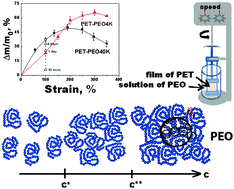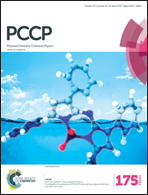Effects of tensile strain on the peculiarities of PEO penetration into the nanoporous structure of PET deformed via the crazing mechanism
Abstract
Solvent crazing involves the development of a highly dispersed fibrillar-porous structure with dimensions of pores and craze fibrils of about 2–20 nm, and crazing by itself can be treated as a universal method for the development of nanoscale porosity. The penetration and release of poly(ethylene oxide) macromolecules into and from the crazes during the development of the nanoporous structure of poly(ethylene terephthalate) have been studied. In particular, PET has been deformed in dilute or semidilute (unentangled as well as entangled) solutions of PEO (a Mw of 4 and 40 kDa) via the mechanism of solvent crazing. Hydrodynamic coil radii Rh, blob sizes ξ, and concentration ranges (crossover and entanglement concentrations) have been determined for the PEO solutions. The evolution of the craze structure (change in porosity W and pore diameters d) has been described as a function of the tensile strain of PET during its drawing in an adsorption-active medium and in the PEO solutions. PEO has been shown to penetrate into the nanoporous structure of the crazes under the conditions corresponding to Rh ≤ d and ξ < d. It has been shown that coagulation processes in the structure of crazed PET, PEO adsorption at the highly developed surface of PET, and the mechanism of PEO transport in the nanopores are equally important factors affecting the direction of the macromolecule mass transfer in the nanopores (penetration or release) and PEO content variation as a function of PET tensile strain.


 Please wait while we load your content...
Please wait while we load your content...